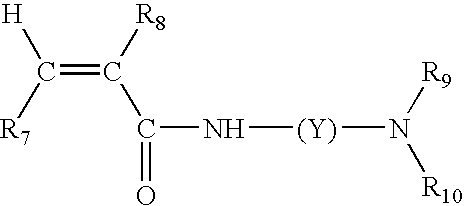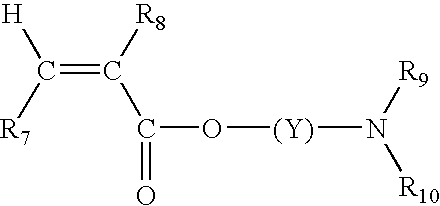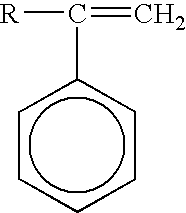Color-stable superabsorbent polymer composition
a superabsorbent polymer and composition technology, applied in the field of sap color degradation, can solve the problems of sap color degradation being too rapid, sap color degradation is too rapid, sap color degradation is not easy to be detected,
- Summary
- Abstract
- Description
- Claims
- Application Information
AI Technical Summary
Benefits of technology
Problems solved by technology
Method used
Image
Examples
example 1
[0122]Acrylic acid (92.4 g), 0.026 g trimethylolpropane triacrylate, and 87.2 g demineralized water were admixed. Sodium carbonate (40.4 g) was added, and the temperature of the monomer solution was maintained below 30° C. during the neutralization reaction. Then, 0.081 g 2,2′-azobisamidinopropane dihydrochloride, 0.018 g DAROCUR® 1173, and 0.040 g hydrogen peroxide were admixed into the monomer mixture. The monomer mixture was heated to 62° C. and poured into a pan, then 0.015 g sodium sulfite, dissolved in 5 g demineralized water, was added to initiate the polymerization. Due to the heat of polymerization, the major part of the water evaporated during the reaction, and at the end of the polymerization, a polymer mass having a residual moisture content of about 15 wt. % was obtained. The polymer mass was placed under UV light (UV intensity=20 mW / cm2) for 8 minutes, then dried in a drying oven at 120° C., milled, and classified to a particle size distribution 106-850 μm. The dry pow...
example 2
[0124]Acrylic acid (29.4 g), 0.04 g tetraallyl ammonium chloride, and 87.2 g demineralized water were admixed. Sodium carbonate (40.4 g) was added, and the temperature of the monomer solution was maintained below 30° C. during the neutralization reaction. Then, 0.081 g 2,2′-azobisamidinopropane dihydrochloride, 0.018 g DAROCUR® 1173, and 0.040 g hydrogen peroxide were admixed into the monomer mixture. The monomer mixture was heated to 62° C. and poured into a pan, then 0.018 g 2-hydroxy-2-sulfinatoacetic acid, disodium salt (BRUGGOLITE® FF7, commercially available from Bruggemann Chemical), dissolved in 5 g demineralized water, was added to initiate the polymerization. Due to the heat of polymerization, the major part of the water evaporated during the reaction, and at the end of the polymerization, a polymer mass having a residual moisture content of about 15 wt. % was obtained. The polymer mass was placed under UV light (UV intensity=20 mW / cm2) for 12 minutes, then dried in a dryi...
PUM
| Property | Measurement | Unit |
|---|---|---|
| temperature | aaaaa | aaaaa |
| temperature | aaaaa | aaaaa |
| temperature | aaaaa | aaaaa |
Abstract
Description
Claims
Application Information
 Login to View More
Login to View More - R&D
- Intellectual Property
- Life Sciences
- Materials
- Tech Scout
- Unparalleled Data Quality
- Higher Quality Content
- 60% Fewer Hallucinations
Browse by: Latest US Patents, China's latest patents, Technical Efficacy Thesaurus, Application Domain, Technology Topic, Popular Technical Reports.
© 2025 PatSnap. All rights reserved.Legal|Privacy policy|Modern Slavery Act Transparency Statement|Sitemap|About US| Contact US: help@patsnap.com



